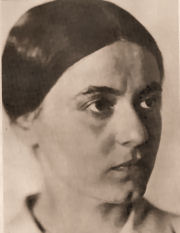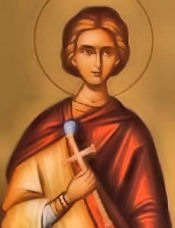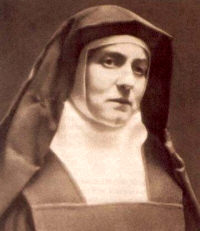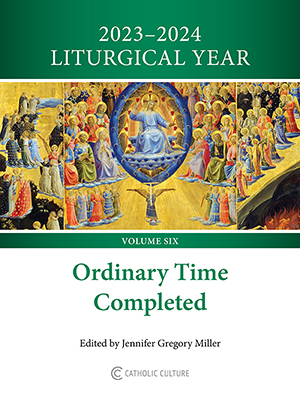Ordinary Time: August 9th
Friday of the Eighteenth Week in Ordinary Time; Opt Mem of St. Teresa Benedicta of the Cross, Virgin and Martyr
Other Commemorations: St. Romanus, Martyr (RM)
» Enjoy our Liturgical Seasons series of e-books!
The Church celebrates the Optional Memorial of St. Teresa Benedicta of the Cross (1891-1942), also known as St. Edith Stein. Edith Stein was born of Jewish parents in 1891, becoming an influential philosopher following her extensive studies at major German universities. After her conversion to Catholicism, she became a major force in German intellectual life, entering the Discalced Carmelites in 1933, and taking the name Sister Teresa Benedicta of the Cross. She was arrested by the Nazi regime in 1942, along with all Catholics of Jewish extraction and transported by cattle train to the death camp of Auschwitz. She died in the gas chambers at Auschwitz that same year.
The Roman Martyrology also commemorates St. Romanus (d. 258), a Roman soldier who converted to Christianity by the example of Saint Lawrence of Rome, by whom he was baptized.
St. Teresa Benedicta of the Cross
 A brilliant philosopher who stopped believing in God when she was fourteen, Edith Stein was so captivated by reading the autobiography of Teresa of Avila that she began a spiritual journey that led to her Baptism in 1922. Twelve years later she imitated Teresa by becoming a Carmelite, taking the name Teresa Benedicta of the Cross.
A brilliant philosopher who stopped believing in God when she was fourteen, Edith Stein was so captivated by reading the autobiography of Teresa of Avila that she began a spiritual journey that led to her Baptism in 1922. Twelve years later she imitated Teresa by becoming a Carmelite, taking the name Teresa Benedicta of the Cross.
Born into a prominent Jewish family in Breslau (now Wroclaw, Poland), Edith abandoned Judaism in her teens. As a student at the University of Gottingen, she became fascinated by phenomenology, an approach to philosophy. Excelling as a protege of Edmund Husserl, one of the leading phenomenologists, Edith earned a doctorate in philosophy in 1916. She continued as a university teacher until 1922 when she moved to a Dominican school in Speyer; her appointment as lecturer at the Educational Institute of Munich ended under pressure from the Nazis.
After living in the Cologne Carmel (1934-1938), she moved to the Carmelite monastery in Echt, Netherlands. The Nazis occupied that country in 1940. In retaliation for being denounced by the Dutch bishops, the Nazis arrested all Dutch Jews who had become Christians. Teresa Benedicta and her sister Rosa, also a Catholic, died in a gas chamber in Auschwitz on August 9, 1942.
Pope John Paul II beatified Teresa Benedicta in 1987 and canonized her in 1998.
—Excerpted from the Saint of the Day, Leonard Foley, O.F.M.
Patronage: Europe; against the death of parents; converts; martyrs
Symbols and Representation: Star of David
Highlights and Things to Do:
- In the month of August we celebrate two martyrs of Auschwitz, St. Maximilian Kolbe and St. Teresa Benedicta. We need to pray, hard and often that our world does not return to the inhumanity to man. The acceptance of euthanasia and abortion, embryonic stem cell research, IVF, are the first steps to deciding who can live or who can die. Offer a Mass, say a rosary, offer sacrifices, etc. to end abortion and other sins against mankind. Read about Auschwitz and ponder the modern gas chambers in every state of our Union and resolve to do all that you can to end the killing.
- Read more about Edith Stein:
- To teach the children more about this saint, discuss topics such as these at age-appropriate levels :
- Definition of a martyr.
- Discussion of the Jews as our older brothers and sisters in the Faith. In the Eucharistic Prayer I (the Roman Canon) we refer to "Abraham, our father in faith."
- Discussion of the call of Truth, its claim on us, despite the cost.
- Edith Stein's reason for taking the name "Teresa."
- Discussion of patron saints and what it means to our daily lives.
- For younger children, discuss on simpler terms ideas such as complete love of God; our daily crosses; meaning of sacrifice; and how to make small but meaningful sacrifices for God.
- Edith Stein (St. Teresa Benedicta) was a philosopher and prolific writer. Her writings are available from ICS Publications. Of special note is her Essays on Woman.
- Catholic Culture's library contains two writings of Edith Stein:
- Read Pope Benedict XVI's General Audience on Edith Stein and Maximilian Kolbe.
St. Romanus
 St. Romanus is mentioned in the "Liber Pontificalis" with three other ecclesiastics as companions in the martyrdom of St. Lawrence. There is no reason to doubt that this mention rests upon a genuine ancient tradition. Like St. Lawrence, Romanus was buried in the Catacomb of the Cyriaca on the Via Tiburtina. The grave of St. Romanus is explicitly mentioned in the Itineraries of the seventh century. In the purely legendary Acts of St. Lawrence, the ostiary Romanus is transformed into a soldier, and an account in accordance with this statement was inserted in the historical martyrologies and in the present Roman Martyrology, in which the latter places his feast on August 9.
St. Romanus is mentioned in the "Liber Pontificalis" with three other ecclesiastics as companions in the martyrdom of St. Lawrence. There is no reason to doubt that this mention rests upon a genuine ancient tradition. Like St. Lawrence, Romanus was buried in the Catacomb of the Cyriaca on the Via Tiburtina. The grave of St. Romanus is explicitly mentioned in the Itineraries of the seventh century. In the purely legendary Acts of St. Lawrence, the ostiary Romanus is transformed into a soldier, and an account in accordance with this statement was inserted in the historical martyrologies and in the present Roman Martyrology, in which the latter places his feast on August 9.
—Excerpted from The Catholic Encyclopedia
Highlights and Things To Do:
- Find out more about St. Romanus:
- See St. Romanus' statue in St. Peter's Colonnade.
- St. Romanus' relics can be found in St. Lawrence Outside the Walls of Rome and St. Catherine of Funari.







